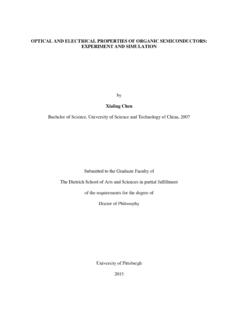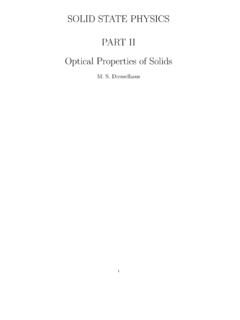Transcription of Calculations of Optical Properties for Quaternary III-V ...
1 Calculations of Optical Properties for Quaternary III-V Semiconductor Alloys in the Transparent Region and Above ( ). M. Linnik and A. Christou Department of Materials and Nuclear Engineering and Materials Research Science and Engineering Center, University of Maryland, College Park MD 20742. Abstract The modeling of the spectral behavior of the refractive indices of the binary, ternary and Quaternary III-V semiconductor alloys in the energy range from to 4eV, including the transparent region, is presented. The extended model of interband transition contributions incorporates not only the fundamental absorption edge contribution to the dielectric function, but also contributions from higher energy and indirect transitions. It is demonstrated that indirect energy transitions must be included in the Calculations of the complex dielectric function of the material in the transparent region. Indirect transitions from different critical points in the Brillouin zone are treated separately. The comparison between the theoretical refractive indices and the experimental data for AlGaAsSb, AlGaInAs, AlGaInP, GaInAsSb, and GaInPAs alloys is presented.
2 These Calculations have been applied to the design of Bragg mirrors with the highest refractive index contrast for heterostructure lasers. Keywords: dielectric constant, compound semiconductors , Optical Properties , interband transition contributions. Introduction The design and analysis of such devices as injection lasers, photodiodes, detectors, solar cells, multilayer structures, and microcavities requires the exact knowledge of the Optical constants of III-V . compound semiconductors in the region near the fundamental absorption edge as well as at the higher photon energies. The refractive indices have been reported for many III-V binary, as well as for limited number of ternary compounds. However, this data is limited and does not extend to many compounds of present interest. It is therefore important to develop a theoretical model, which is both extensive and accurate. In modeling of the Optical constants of semiconductors in the fundamental Optical region, several approaches are typically used: (1) empirical formulas, (2) damped harmonic oscillator (DHO) models, (3).
3 Standard critical point (SCP) models. Optical constants determined from empirical formulas (such as the Sellmeier dispersion equations for the refractive index and Urbach's rule for the absorption coefficient [1], 1. or the expression for n based on interpolation of a dielectric quantity using Vegard's rule by Burkhard et al.[2]) are not related through the Kramers-Kronig dispersion relation and are valid only over a very limited energy range. A semi-emperical single effective oscillator model proposed by Wemple et al.[3] does provide an analytical expression for the dispersion of the semiconductor refractive index at photon energies significantly below the direct band edge. The harmonic oscillator model does not incorporate the concept of the Optical energy band gap. Thus, the Optical energy band gap of semiconductors cannot be directly determined from this approach [4]. This model also lacks the agreement with experimental data at the band edge, which is the energy range of the most interest for semiconductor laser devices.
4 When the photon energy is smaller than the band gap energy, the quasi-classical Boltzmann equation or Drude theory based on a simple harmonic oscillator model can be applied [1]. However, the Drude theory ignores the carrier related effects around the band gap and the results are valid only in the low Optical frequency region. An extension of the Drude theory through the quantum density matrix method has been presented by Jensen et al.[5]. The experimentally observed dispersion of the refractive index near the fundamental absorption edge can be accounted for by a quantum mechanical calculation , which modifies the wavelength dependence predicted by the classical Drude theory. This approach differs from the usual method of the refraction index calculation , which involves the initial calculation of the imaginary part of the dielectric constant and integrating it using the Kramers-Kronig relation to obtain the real part of the dielectric constant. The advantage of this method is that an expression for the index of refraction, n, can be obtained in terms of band structure parameters, such as the energy band gap, Eg, the spin-orbit splitting energy, , and the effective masses.
5 The standard critical point (SCP) model can determine the position of critical points of the semiconductor band structure, but cannot accurately predict the dielectric function [4]. The modified SCP. model was initially proposed by Korovin [6] and Cardona et al.[7], and then developed by Adachi [8], and Lin et al.[9]. The model of interband transition contributions (ITC model) was introduced as a method to analyze the refractive index of III-V compounds at energies below and above the direct band gap by including the electron-hole pair transitions, and by adding the excitonic terms at the two lowest energy gap transitions. The comparison between available experimental results of the spectral behavior of III-V . compound semiconductors and the theoretical data calculated using the above mentioned models often reveals a lack of agreement, which is pronounced for the photon energies around the fundamental absorption edge. These differences may arise from the excitonic effects, which are largely ignored in the Calculations of the real part of the dielectric constant [9].
6 In the present work, an extended model of interband transition contributions (EITC) is developed for the Calculations of real and imaginary parts of the dielectric constant of compound semiconductors . The 2. model introduces (1) the broadening effects, caused by phonon and defect scattering in direct and indirect transitions; (2) the strength of direct band gap transitions as a function of the effective electron, heavy hole and light hole masses of the semiconductor; (3) the exciton contributions; (4) the separate contributions of Ex and El indirect band gap transitions to the real and imaginary part of the dielectric constant. The importance of indirect and higher direct energy transitions is demonstrated through these Calculations and through the comparison with experimental results. The detailed description of our extended ITC model is given in the Appendix. We note that a parameter fit is required for the present extended ITC model, which is similar to the SCP model parameter fitting.
7 However, after the above listed changes are introduced into the SCP model, the resulted extended ITC theoretical model shows better agreement with available experimental results. The index of refraction for the following alloys has been calculated: AlP, AlAs, AlSb, GaP, GaAs, GaSb, InP, InAs, InSb, AlGaAsSb, AlGaInAs, AlGaInP, GaInAsSb, and GaInPAs. The comparison between the available experimental and calculated data is presented for the above mentioned Quaternary semiconductor alloys. Finally, we have used the results of these Calculations in the design of Bragg mirrors for Vertical Cavity Surface Emitting Lasers. The Extended ITC Model The dielectric constant (E) = 1(E)+i 2(E) describes the Optical response of the medium as a function of photon energy E. The imaginary part of the dielectric function 2(E) is calculated based on a simplified model of the band structure using the joint density of states for each Critical Point (CP). considered. The real part of the dielectric function 1(E) was calculated through the knowledge of the imaginary part, 2(E), by employing the Kramers-Kronig relation [10].
8 Thus, the total imaginary and real parts of the dielectric function are presented as a sum of several terms that represent the contribution of different energy CPs. These points are associated with electronic transitions in the band structure at the energies designated as E0, E0+ , E0ex, E1, E2, and Ei. In case of ternary, AxB1-xC, and Quaternary , AxB1- xCyD1-y, semiconductor alloys each of the terms become a function of the alloy mole fraction, x and y. There are several absorption mechanisms [11] that contribute to the imaginary part of the dielectric constant, therefore 2(E) can be written as: ! 2 ( E , x , y ) = ! 2Eo ( E , x , y ) + ! 2exEo ( E , x , y ) + ! 2Eo + " ( E , x , y ) +. (1). + ! 2E 1 ( E , x , y ) + ! 2E 2 ( E , x , y ) + ! 2Ei ( E , x , y ). where 2Eo and 2Eo+ are contributions due to the absorption by direct interband Optical transitions near the fundamental absorption edge and spin-orbit transitions, 2exEo is due to the absorption by the discrete series of excitons near the E0 energy gap, 2E1 and 2E2 are contributions of the higher energy interband transitions, and 2Ei is due to the indirect interband absorption effects.
9 3. The absorption spectrum for photon energies greater than the band gap energy is composed of many peaks correlated with Van-Hove singularities of the joint density of states [11]. For III-V zinc-blende type semiconductors , the contributions of two main peaks (E1 and E2) must also be included. These peaks correspond to the direct Optical transitions at the L and X points of the BZ, respectively. The E1 peak is treated as a two dimensional M0 type critical point, while the structure of the E2 peak is characteristic of a damped harmonic oscillator. The E1 peak arises from the transitions occurring over a large portion of the BZ around the L critical point (CP), between the upper valence band (VB) and the lowest conduction band (CB) along the <111> direction in the Brillouin zone. The higher interband transitions in the X region, along the <100> direction, usually do not correspond to a single well defined critical point (CP). The peak is assumed as a combination of several transitions resulting in a peak in the joint density of states.
10 These transitions can occur between the upper VB and the lower components of the second CB around the CP, between the upper VB and the second lowest CB plus spin-orbit splitting component, between the upper VB and lower CB along the <100> X direction. Because the investigated model is concerned primarily with the lower energy transitions, the higher interband transition contributions from the X region were modeled as a constant M contribution. Similarly, the real part of the dielectric function can be presented as the following sum: ! 1 ( E , x , y ) = ! 1Eo ( E , x , y ) + ! 1exEo ( E , x , y ) + ! 1Eo + " ( E , x , y ) +. (2). + ! 1E 1 ( E , x , y ) + ! 1E 2 ( E , x , y ) + ! 1Ei ( Ex , y ). The detailed description of the individual contributions to the real and imaginary parts of the dielectric constant is given in the Appendix. The presented model is applicable in the photon energy range from to about 4eV. The crystal parameters such as energy band gap values, effective electron and hole masses, and static dielectric constant employed in the Calculations are given in the Table 1 [1,12].









